The Thermal Data
Moving on from the restriction test bench the Koolance HX-CU1020V was loaded into the thermal test chamber for a series of tests – consisting of 3 flow rates, each having 3 different fan rpm rates tested. I felt the thermal test data was most important and which you as the reader would be most interested in.
Below is the final data results gathered from at least 2 data logging runs at each flow rate and fan rpm combination. The most stable 15 minute period from each logging run was used and then averaged with the other runs to obtain the data for the table below. A total of 16 temperature sensors were used in the thermal test chamber (8 air in, 2 air out, 3 water in, 3 water out) each take a reading every second and logged via a CrystalFontz unit. The data in the table below is the averaged results of the logging runs which has then been used to create all the plots and tables there-after.
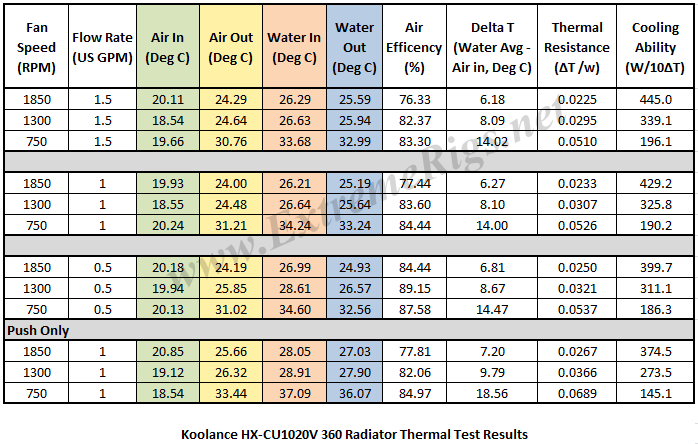 The performance metric of critical importance is the delta between the warm coolant temperature in and the cold ambient air temperature in to the radiator. Given that the system is well insulated and in equilibrium and we know the heat input to the system then we can also calculate a very important number – that is the amount of power required to raise the coolant temperature 1C (or 10C which is more useful reference point).
The performance metric of critical importance is the delta between the warm coolant temperature in and the cold ambient air temperature in to the radiator. Given that the system is well insulated and in equilibrium and we know the heat input to the system then we can also calculate a very important number – that is the amount of power required to raise the coolant temperature 1C (or 10C which is more useful reference point).
Let’s take a look at the Delta T results from the tests.
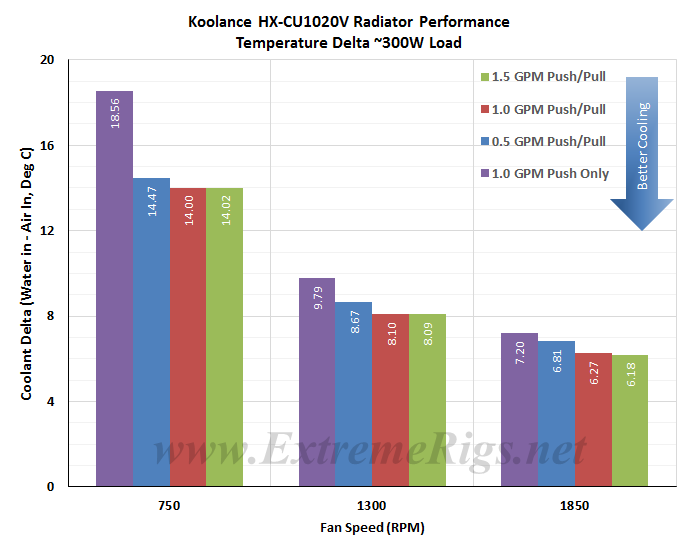 We’re not too concerned about the actual delta numbers here, more so if a trend pattern between fan speeds is occurring. It’s interesting to see the Push Only which is 1.0 gpm draw closer to the 0.5 gpm Push/Pull as the fan speeds increase. Also, what is noticeable is the lack of variance between the 1.0 and 1.5 GPM tests.
We’re not too concerned about the actual delta numbers here, more so if a trend pattern between fan speeds is occurring. It’s interesting to see the Push Only which is 1.0 gpm draw closer to the 0.5 gpm Push/Pull as the fan speeds increase. Also, what is noticeable is the lack of variance between the 1.0 and 1.5 GPM tests.
Delta T results (as above) are not always helpful when thinking about how many radiators you would need to cool your system. Instead it’s more useful to know the delta/W, or more usefully, the inverse metric of W/delta C.
The metric plotted below tells us how many watts are dissipated by the radiator when the coolant rises 10C above ambient temperatures. (W/10 Delta T):
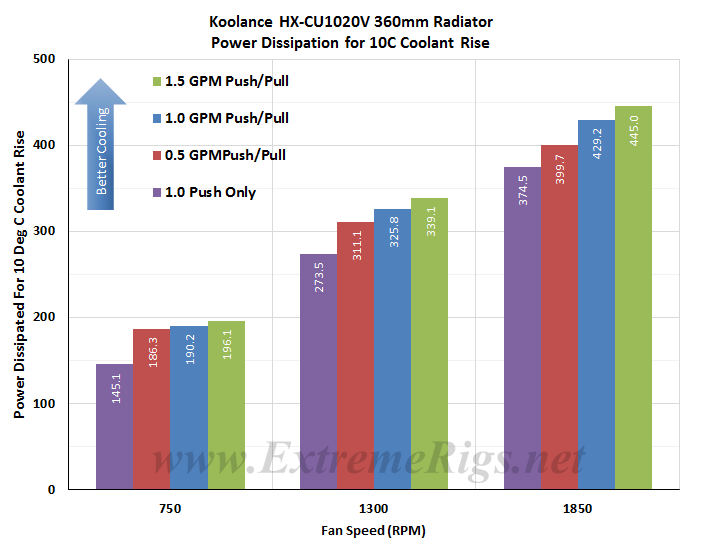 As expected increasing airflow through the radiator is the primary determinant in changing the radiators performance. This looks like a nice even spread.
As expected increasing airflow through the radiator is the primary determinant in changing the radiators performance. This looks like a nice even spread.
This data can now be plotted as a pretty curve so that an end user can interpolate their own fan speed. Note that the extrapolation of the curve is much more sensitive to error than in between the tested range. Let’s exclude the push data for now and come back to it:
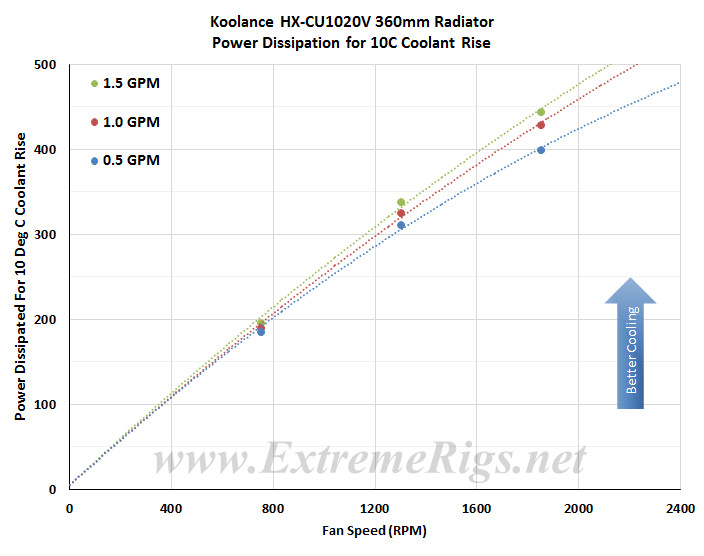 The tightly bunched lines is evidence that increasing flow rate is yielding little benefit in performance, particularly at 1.0 gpm and above.
The tightly bunched lines is evidence that increasing flow rate is yielding little benefit in performance, particularly at 1.0 gpm and above.
If we now come back to the Push Only data it’s good to compare only the push to push/pull data in an “apples to apples” fashion by only looking at the 1GPM data:
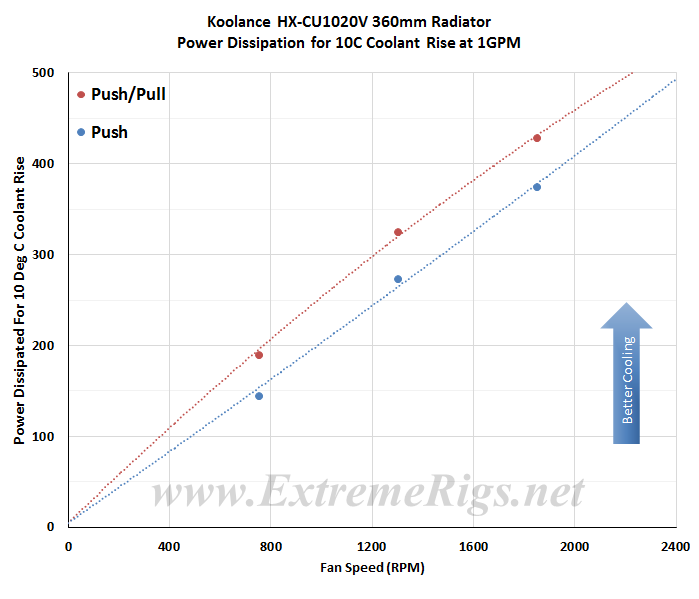 Push only gives around 82% (averaged) of the performance of the Push/Pull 1.0 gpm test results on this radiator. The very straight nature of both the plot lines indicate that the HX-CU1020V has plenty more performance left in the tank, which can only really be unlocked with higher speed/higher pressure (and louder) fans.
Push only gives around 82% (averaged) of the performance of the Push/Pull 1.0 gpm test results on this radiator. The very straight nature of both the plot lines indicate that the HX-CU1020V has plenty more performance left in the tank, which can only really be unlocked with higher speed/higher pressure (and louder) fans.
In this next plots all three results at 1.0 GPM Push Only are used to produce one curve and we compared the results against all of the slim rads we have tested so far.
Push Only first up:
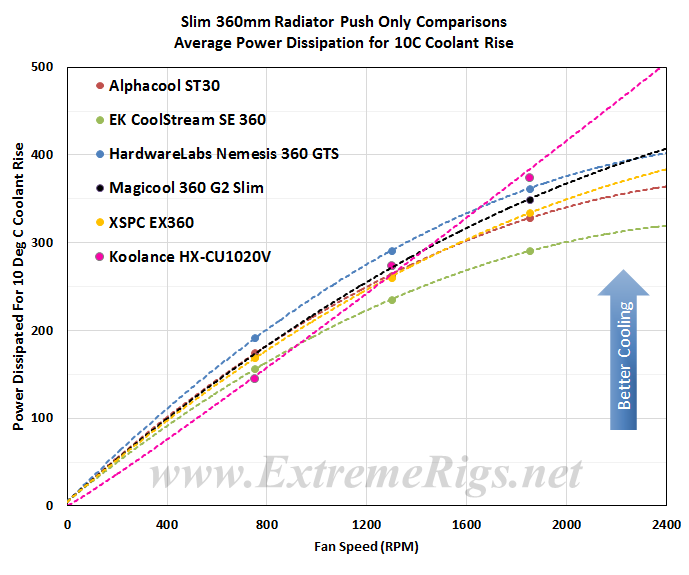 In Push Only, which we believe is the most likely installation scenario for a slim rad, the performance of the HX-CU1020V is rather weak with low speed fans, but moves into the average range with medium speed fans.
In Push Only, which we believe is the most likely installation scenario for a slim rad, the performance of the HX-CU1020V is rather weak with low speed fans, but moves into the average range with medium speed fans.
Now let’s compare Push vs Push/Pull: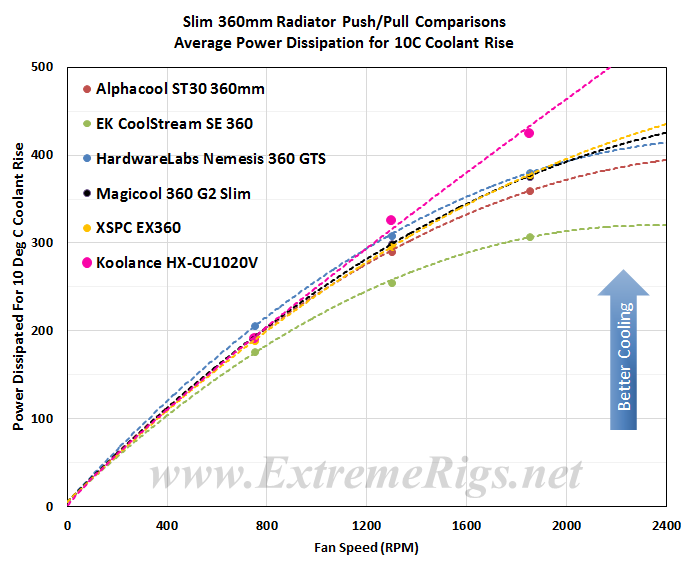 For the Push/Pull comparison chart we have averaged the 3 fan speed test results at each flow rate to produce the curves. Averaging reduces test error of course so this helps further to be sure of our data and is more useful therefore for comparing to other radiators.
For the Push/Pull comparison chart we have averaged the 3 fan speed test results at each flow rate to produce the curves. Averaging reduces test error of course so this helps further to be sure of our data and is more useful therefore for comparing to other radiators.
The HX-CU1020V is clearly the best performing rad of the group in both the Push Only and Push/Pull with high speed fan assemblies.
Now let’s analyze that data some more…








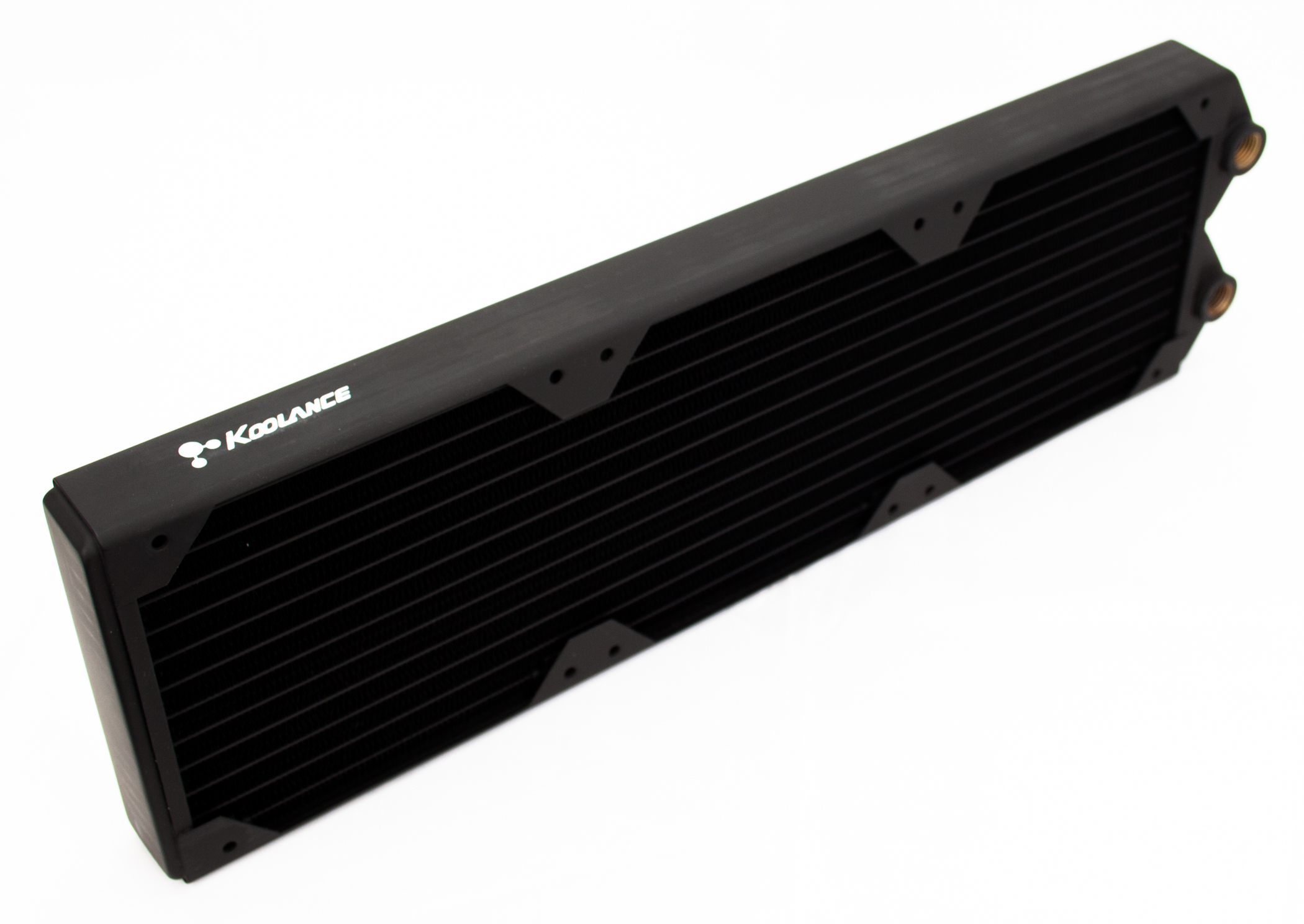



Okay, so this is the antithesis of the Nemesis GTS: great at push pull high speeds, were as the Nemesis GTS is king of push only low / medium speeds. Glad I got two Nemesis GTS for my build.
As always, thank you for the great review and additional data to the radiator database.
[…] Koolance HX-CU1020V 360mm Radiator Review […]
Your overall score lacks the scrutiny and precision that you have applied to your superb test and measurement criteria.
The feature set (extra ports, etc.) and paint finish have no bearing on thermal performance and when this low marking for ‘features & quality’ is applied as a major constituent of the overall summary score this excellent radiator immediately looks second rate to the casual reader and beginner in the field of water-cooling.
Many people who visit your site will not read or necessarily understand your entire review or the graphs which look at factors outside the original design spec for this radiator, i.e. it was not really intended to be used with low speed fans, hence the high fin density. Also most enthusiast and professional builders will be using a push/pull design, high static pressure fans and, spacing permitting, shrouds to reduce the ‘dead spot’ created by 120mm fan centre hubs ( or 140mm based radiators)
You write for a site called extremerigs not ‘boy racer add-ons’ and although I do not dispute the fairness and balance within your text, other than the over-emphasis on “extreme restriction” which is easily overcome, your final score is misleading. I am not suggesting that you are being specifically unfair to Koolance, but in my standing as a Senior Design Engineer in many fields of engineering for the past 24 years, your scoring puts too much emphasis on the non-essential.
As an enthusiast, I have built 80+ water-cooled rigs since 2003, three of them with large industrial grade heat exchangers (peltier based) running coolant down to -55 Celsius. Most people cannot afford or be bothered with the complexity of ‘chilled’ systems, but multiple radiator systems have become increasingly popular over the past decade. I have used multiple units of this excellent radiator and its thicker ‘big brother’ in more than 30 builds and various HW Labs Black Ice variants in around 20 builds with complex Quad SLI configurations without any issues or compromise!
Unfortunately, over the past 3 years the market has become flooded with flashy ‘boy racer’ radiators which may look impressive and have many extra features, but in what ways do these improve cooling performance?
Many of these features are about as useful as the range of ‘viewing windows’ which were being sold for HDs and PSUs until the worldwide economic crisis hit. I do not dispute that some features make the design process easier when deciding the route for tubing to water-blocks and manifolds, but adding a ‘universal’ feature set to every radiator design will add unnecessary cost.
Comments are closed.